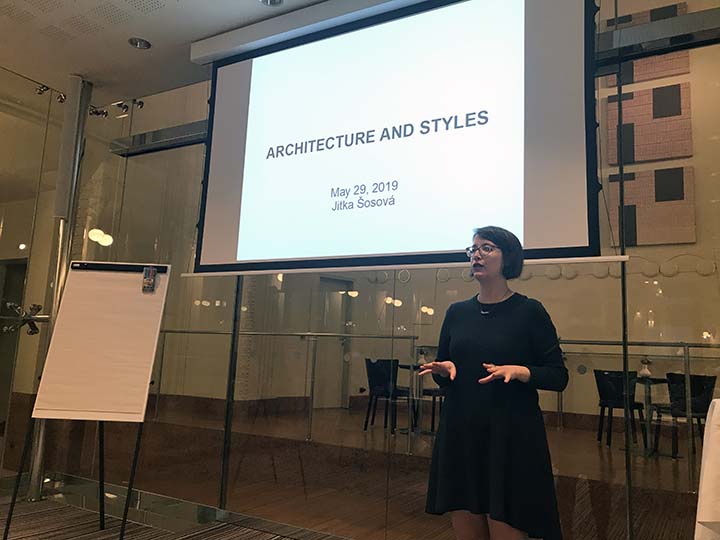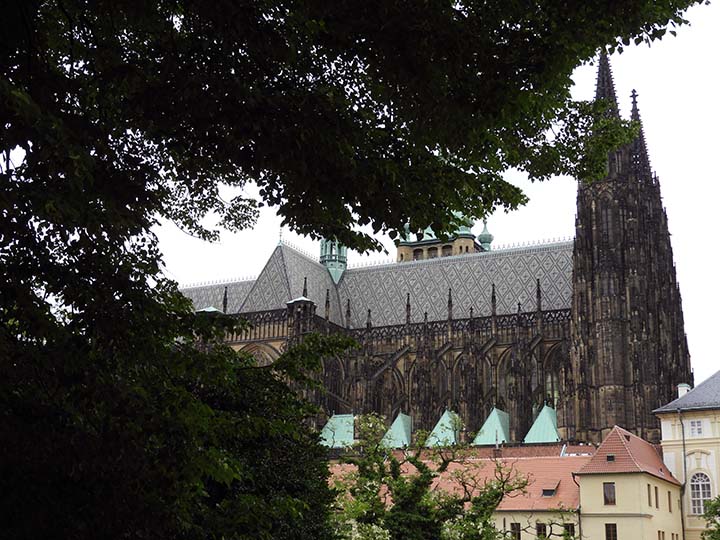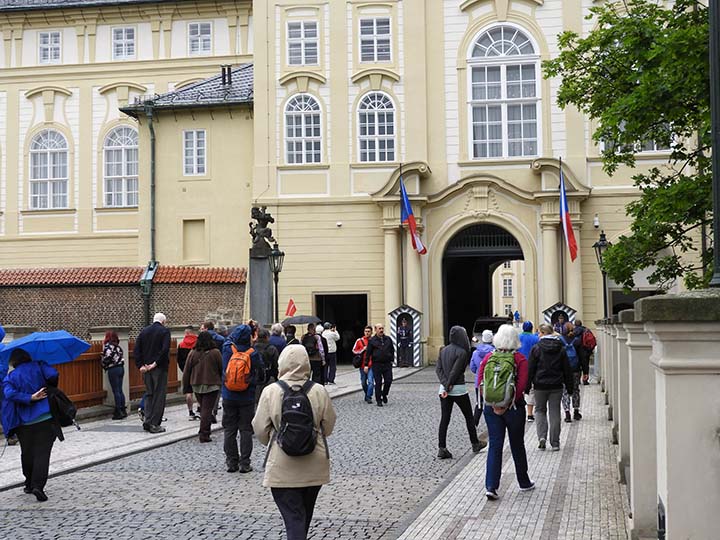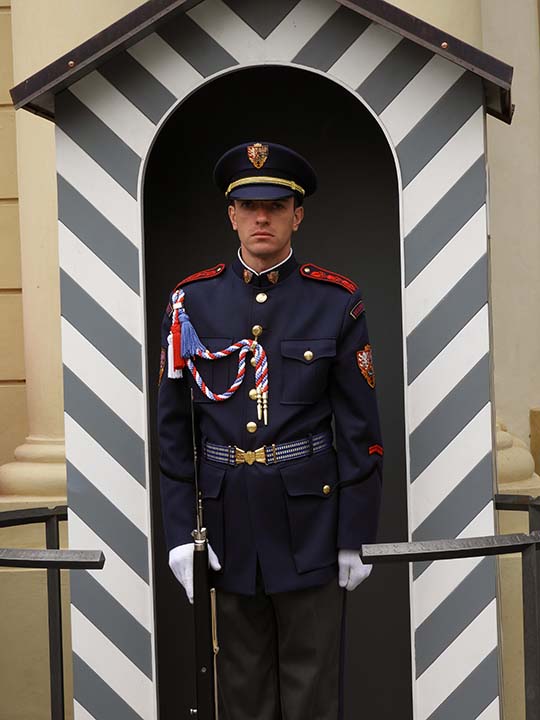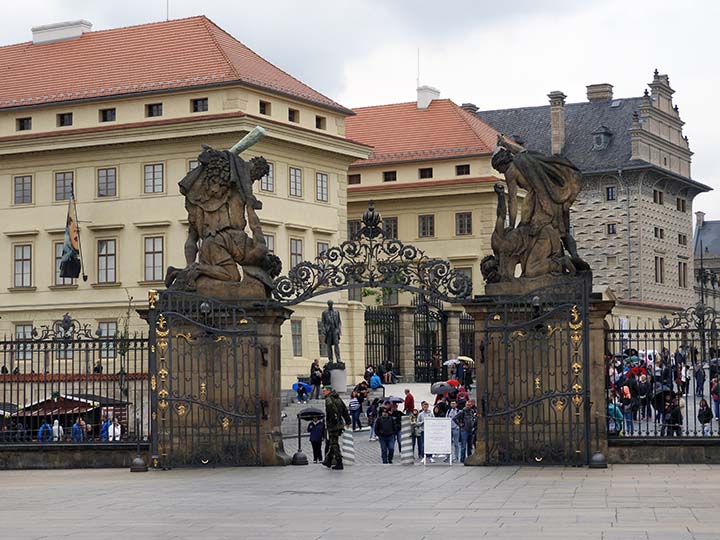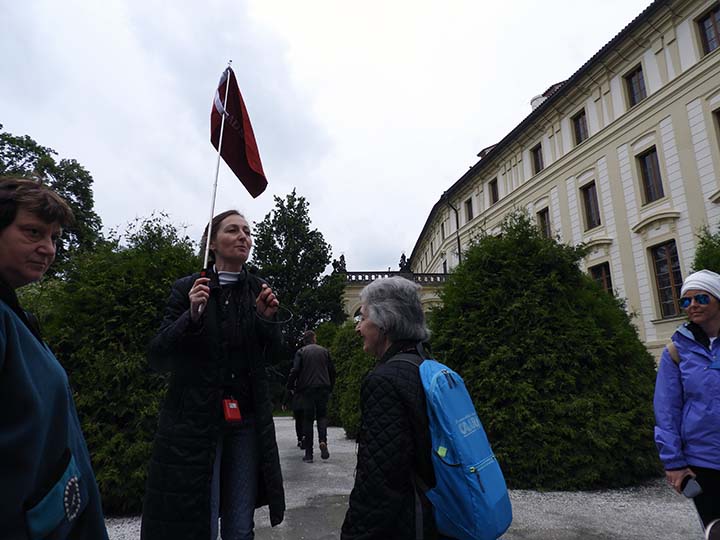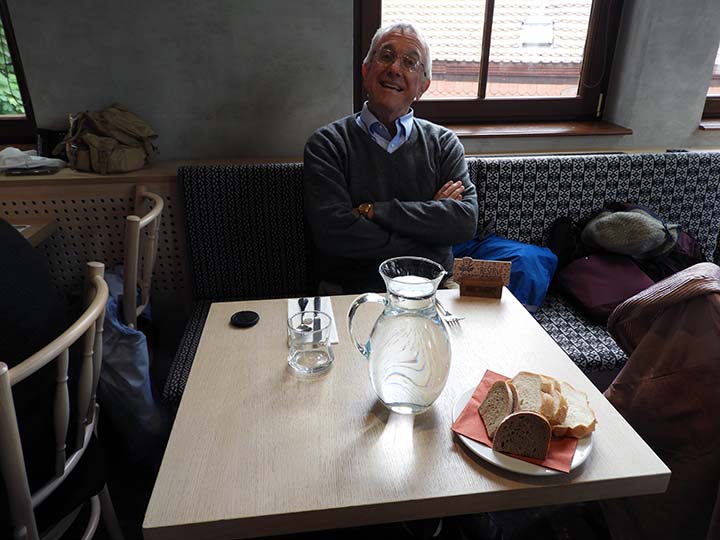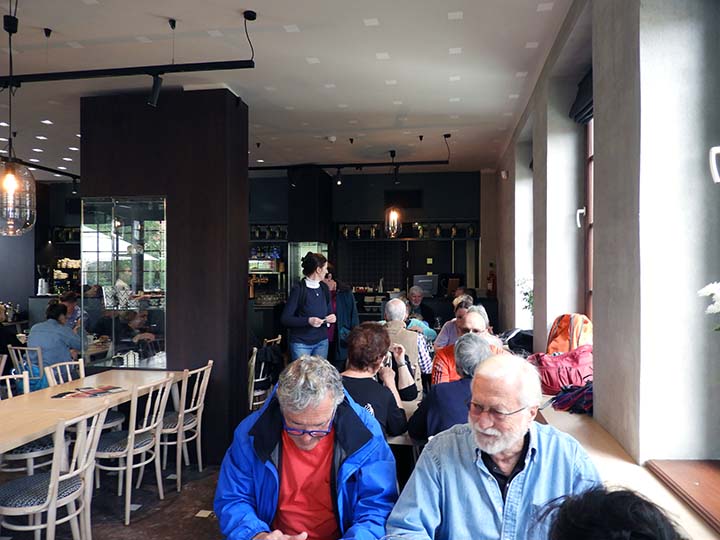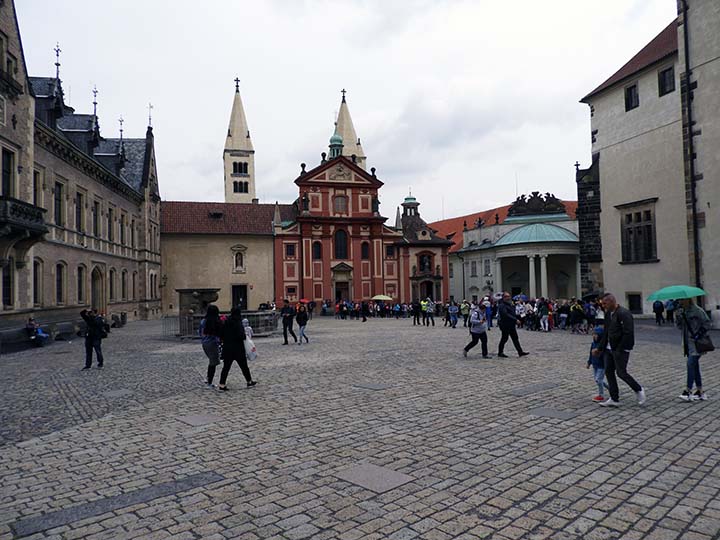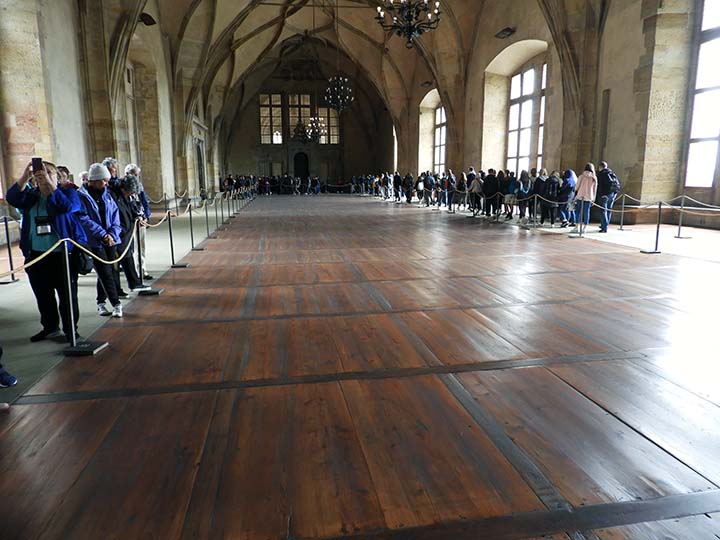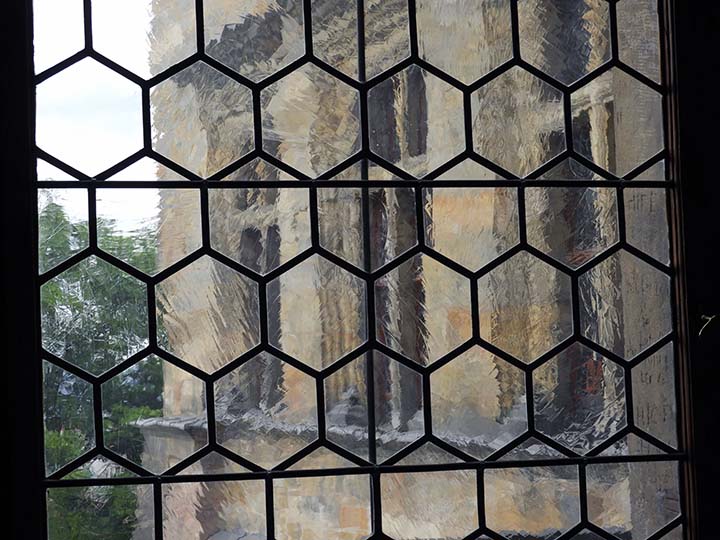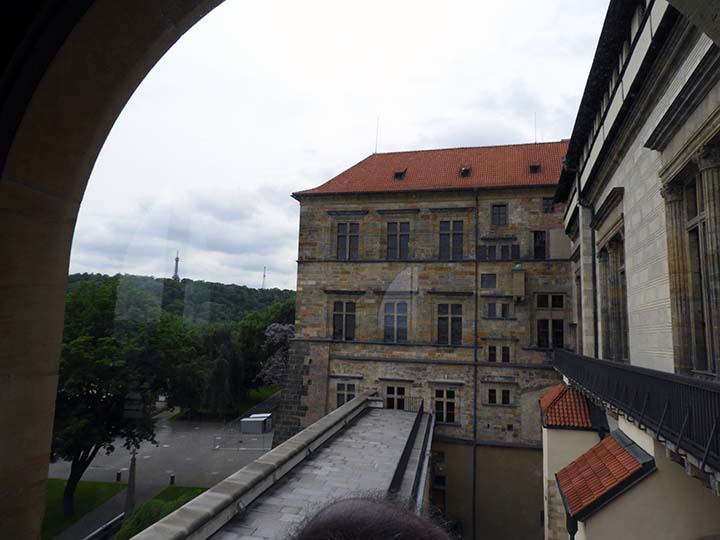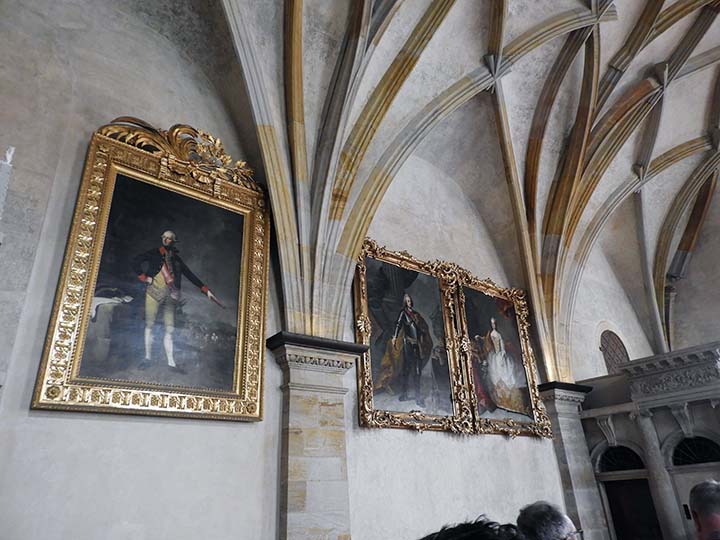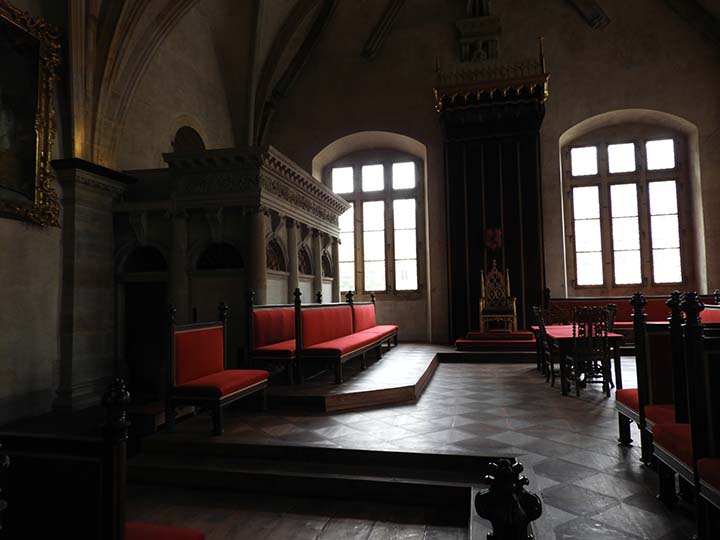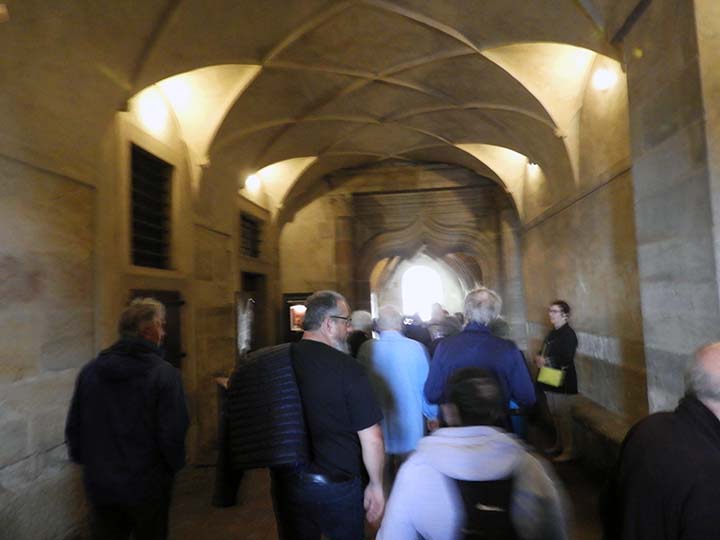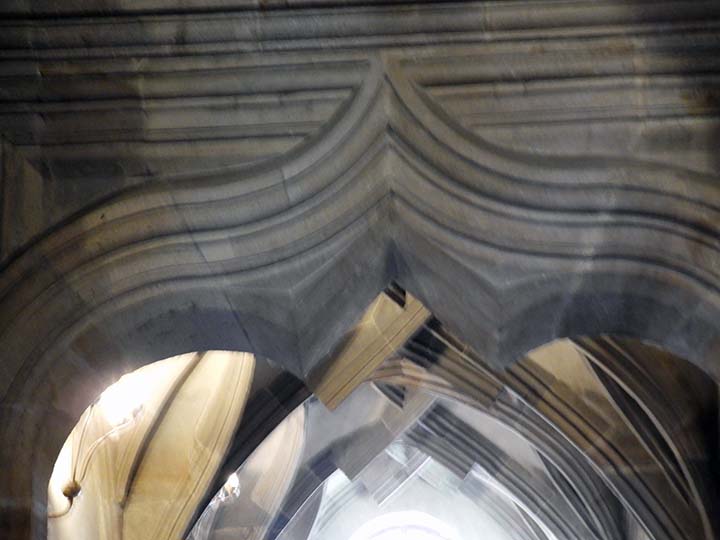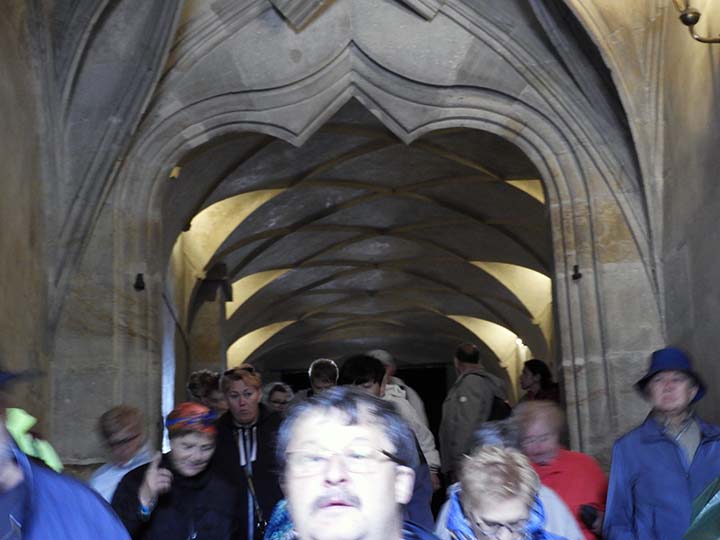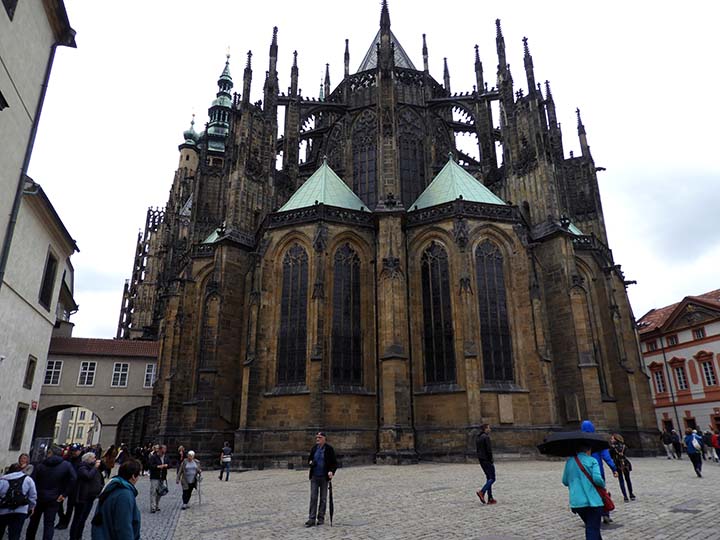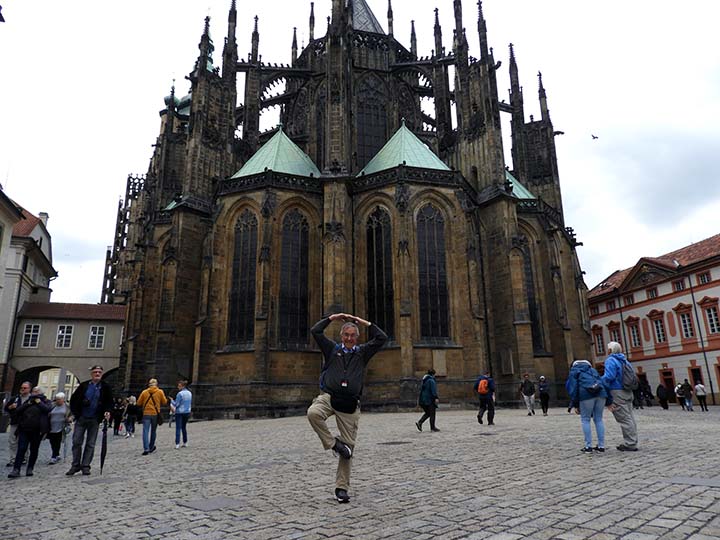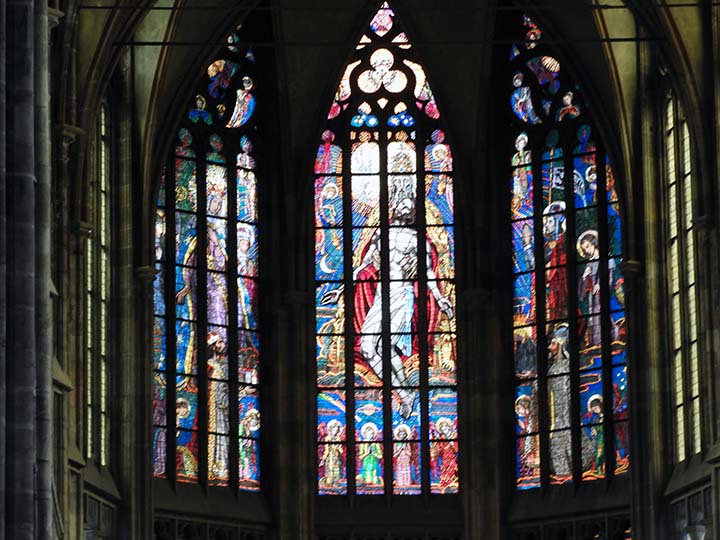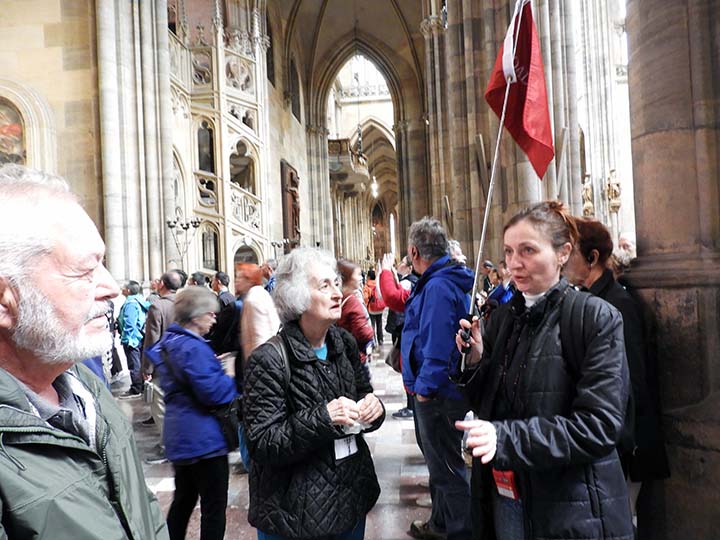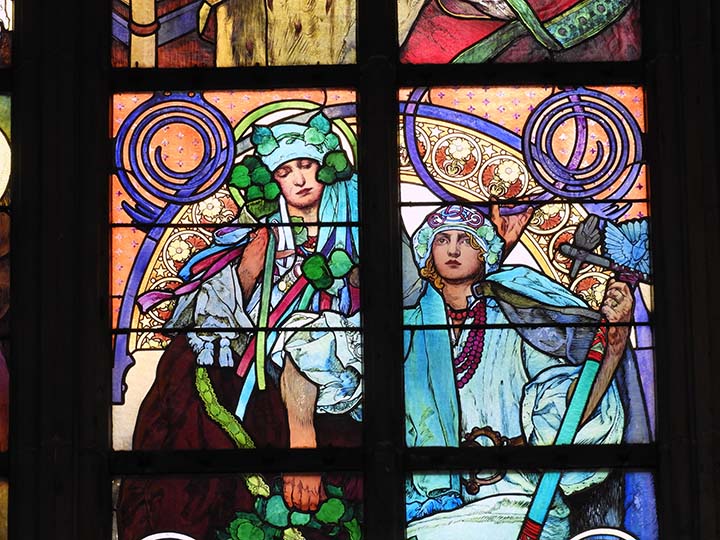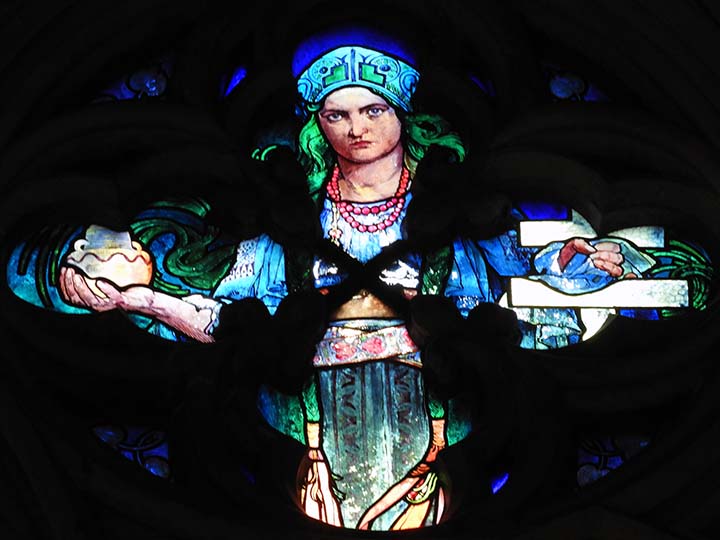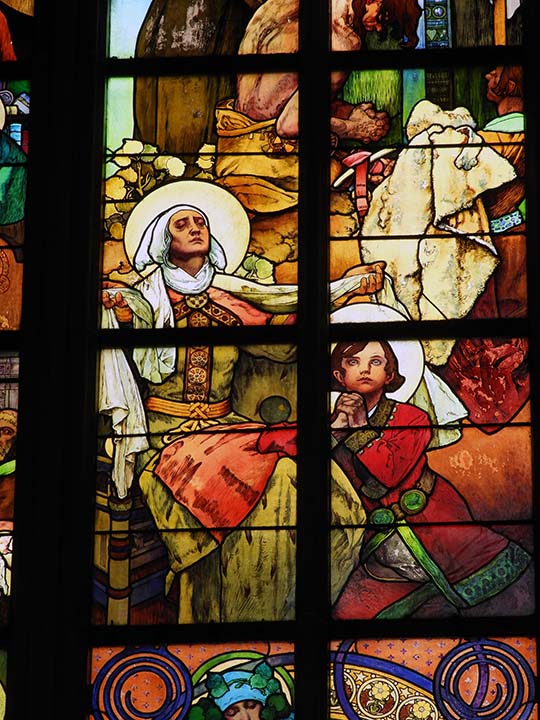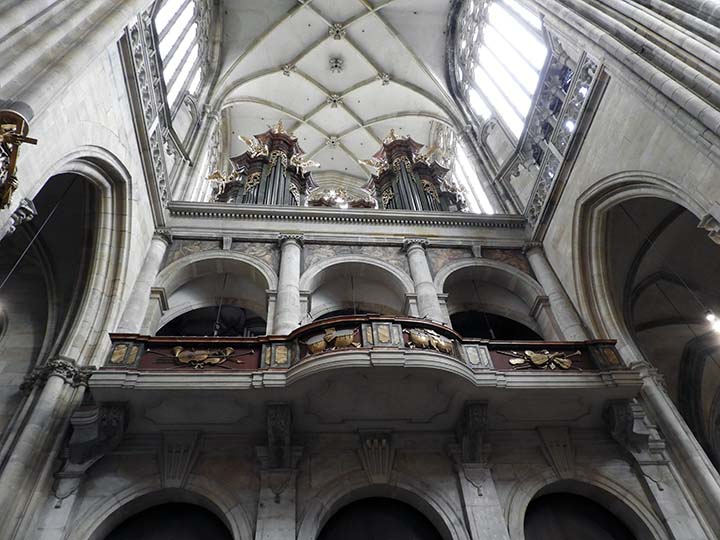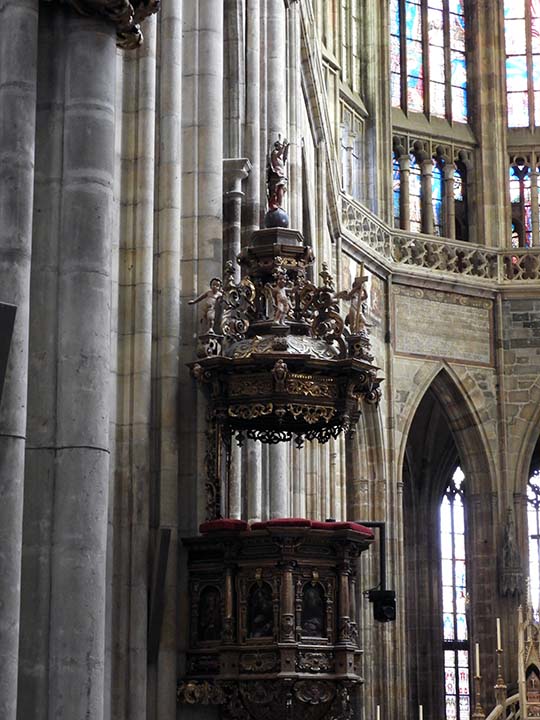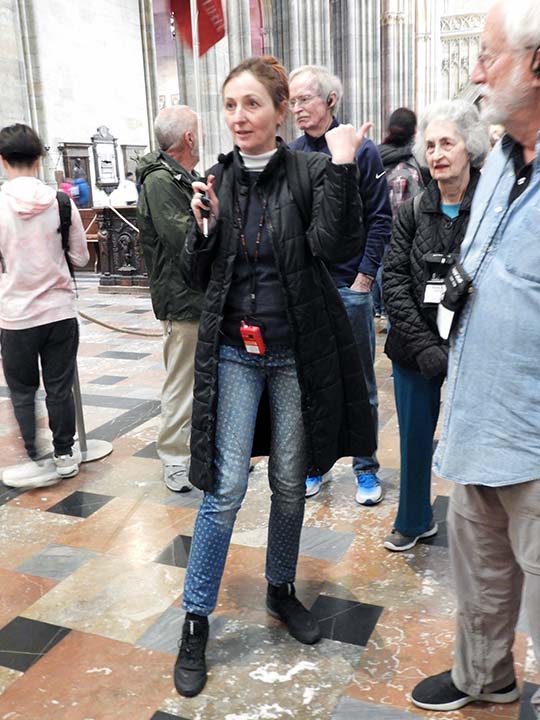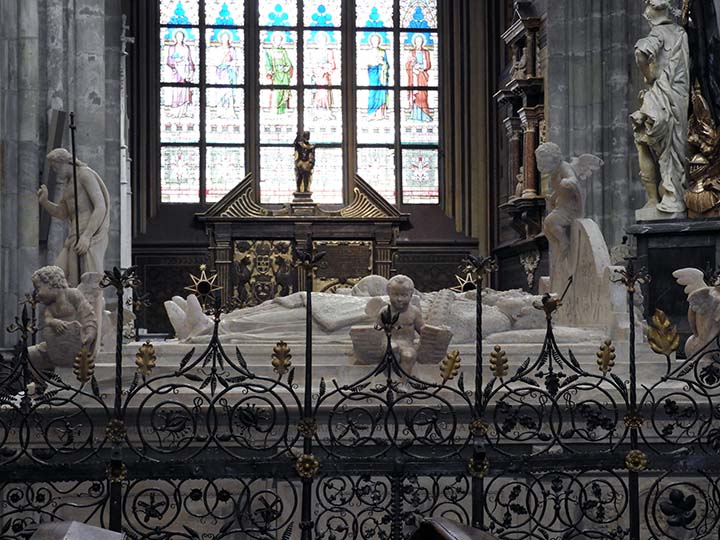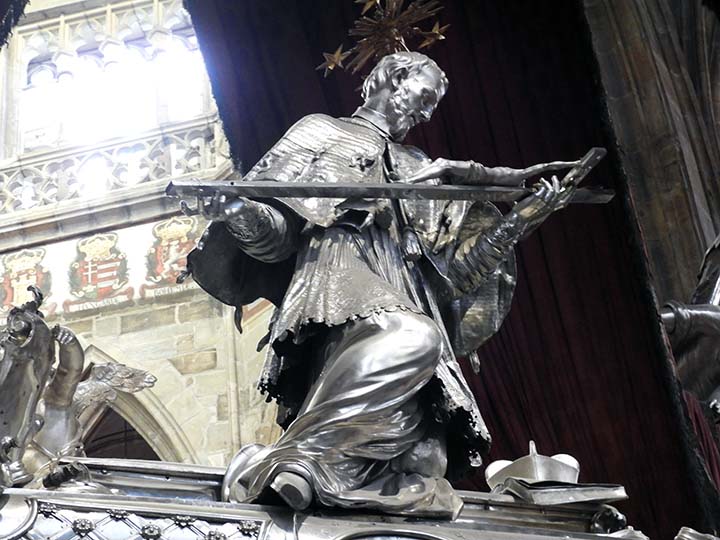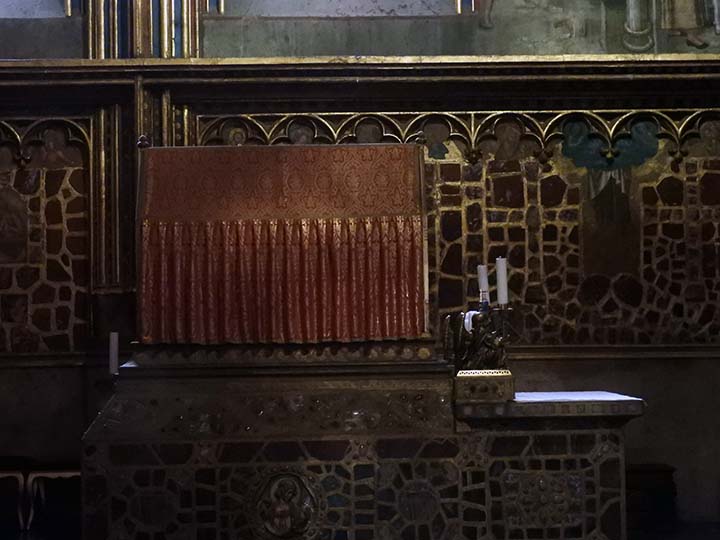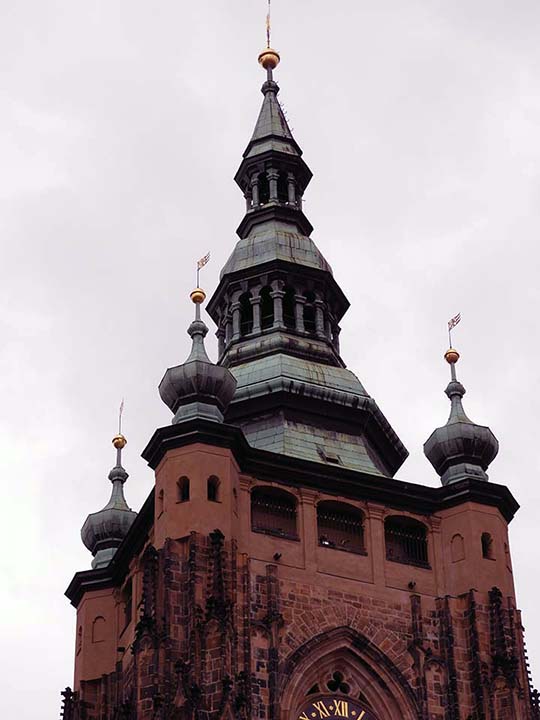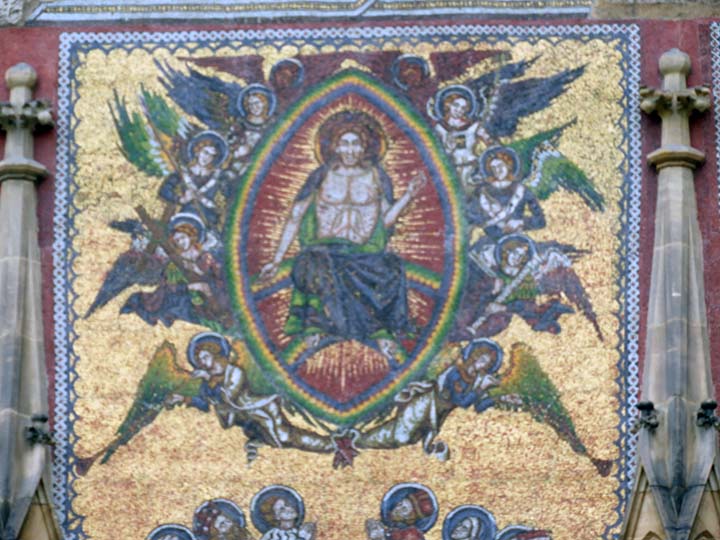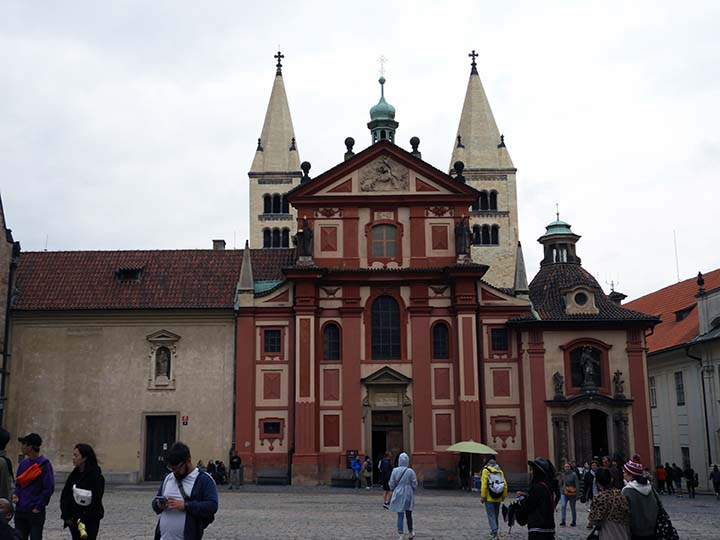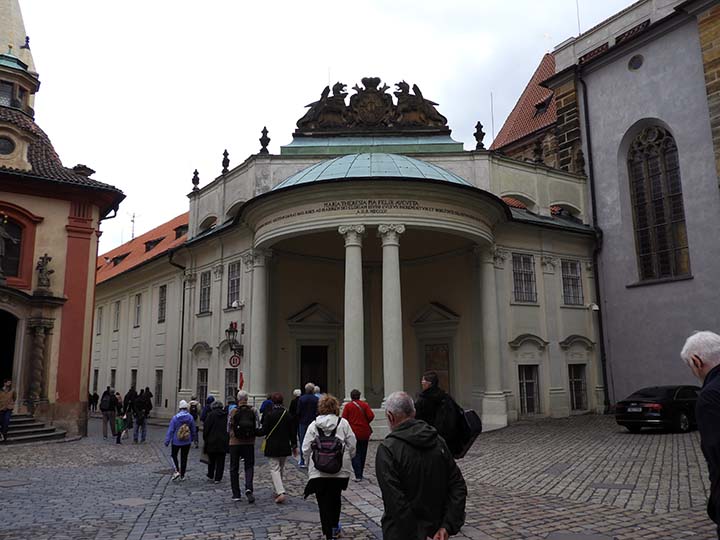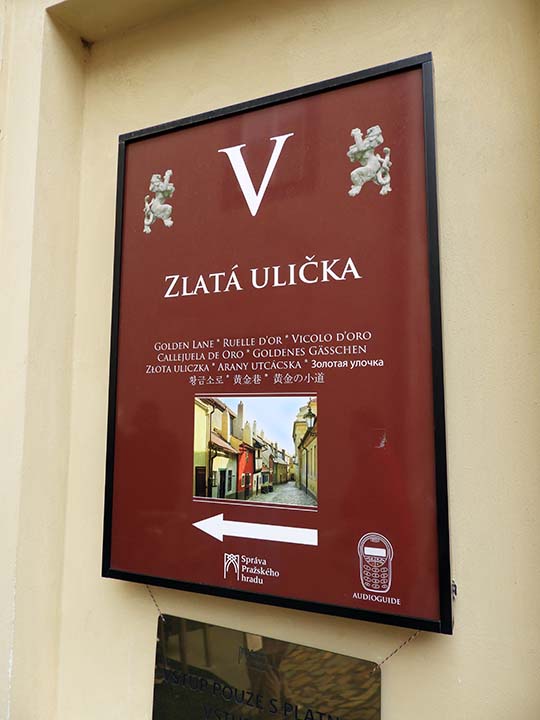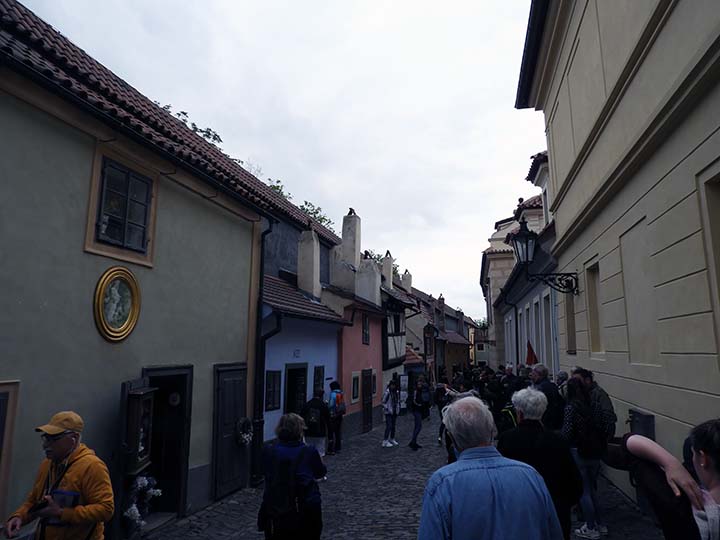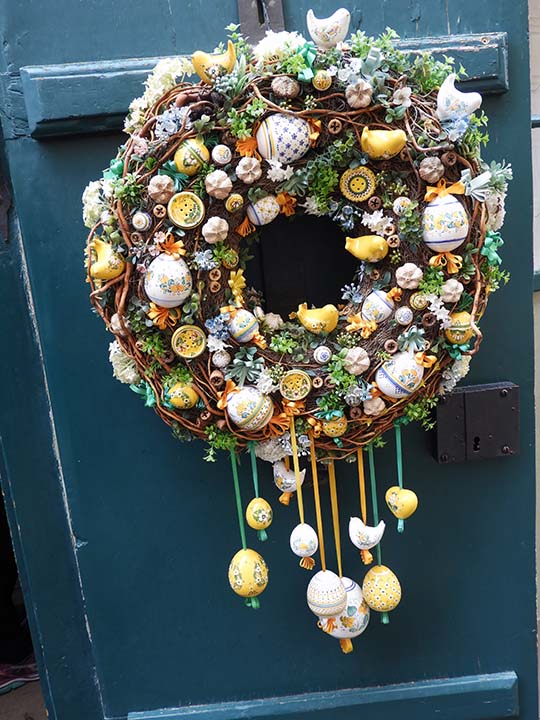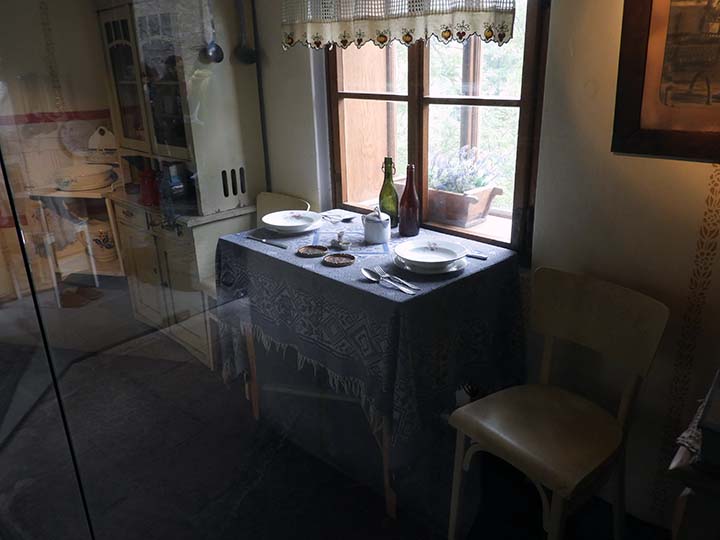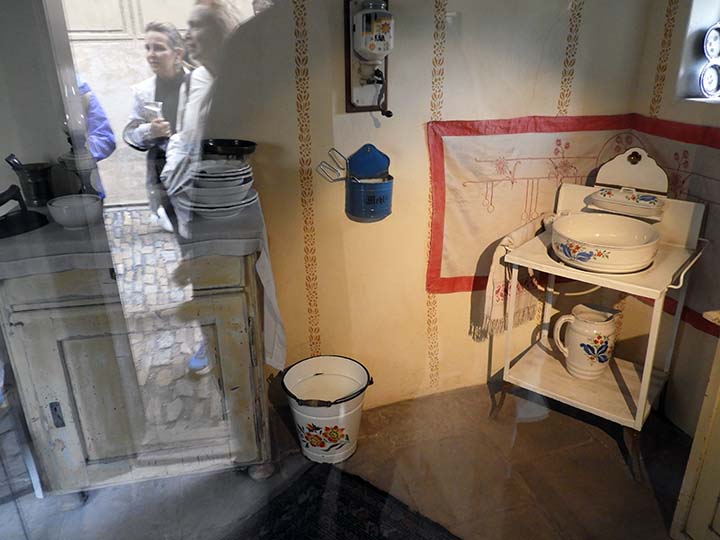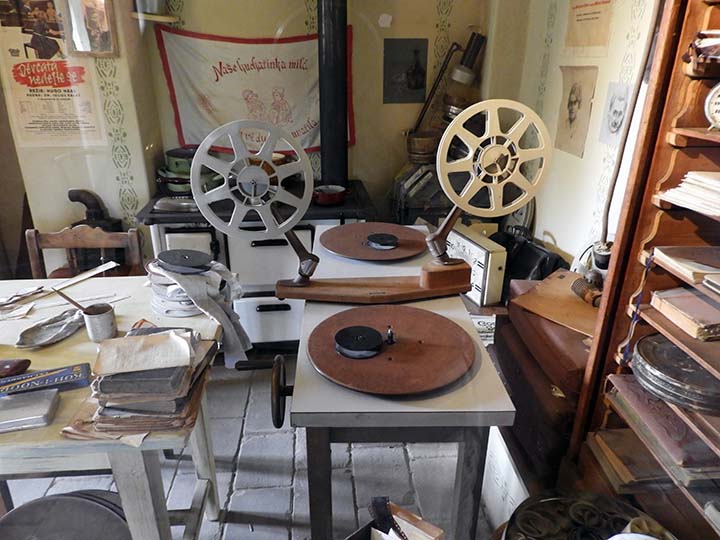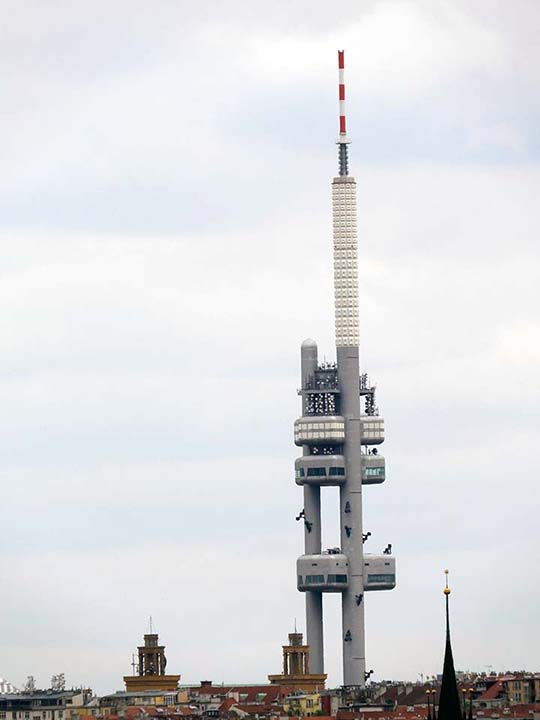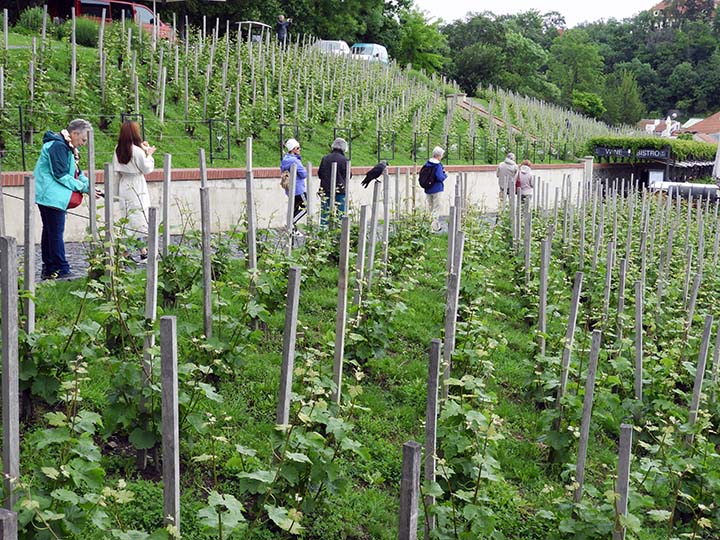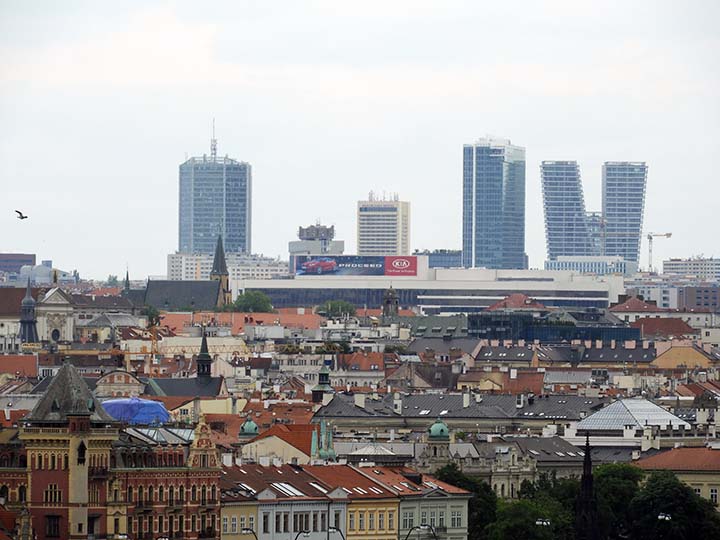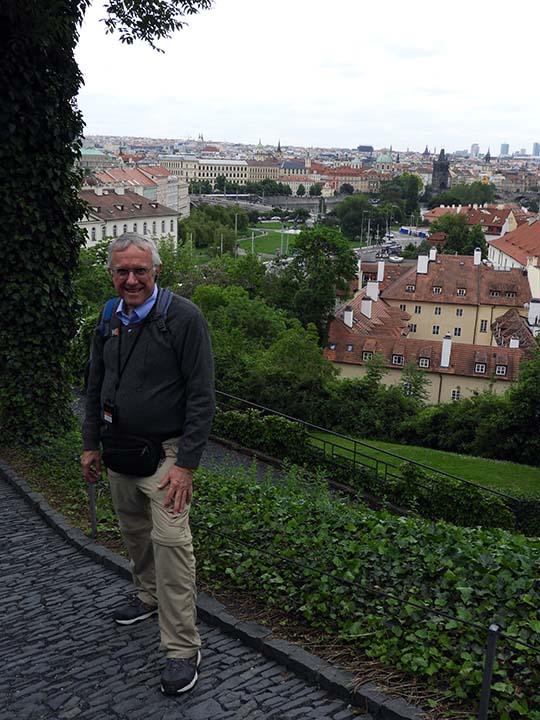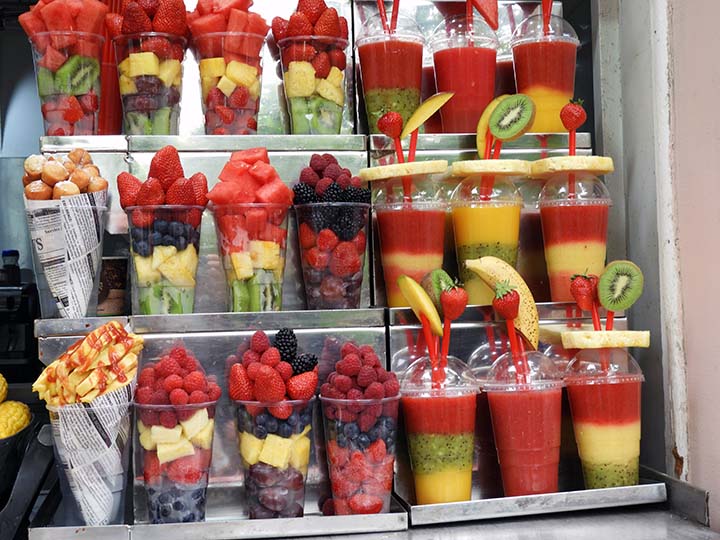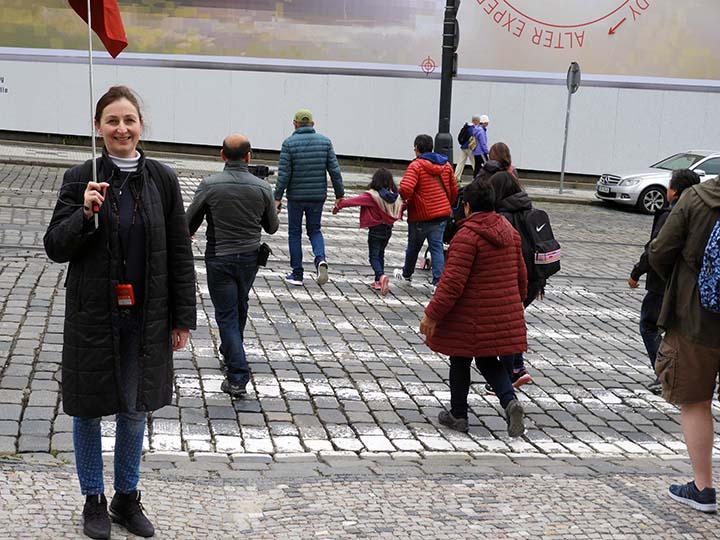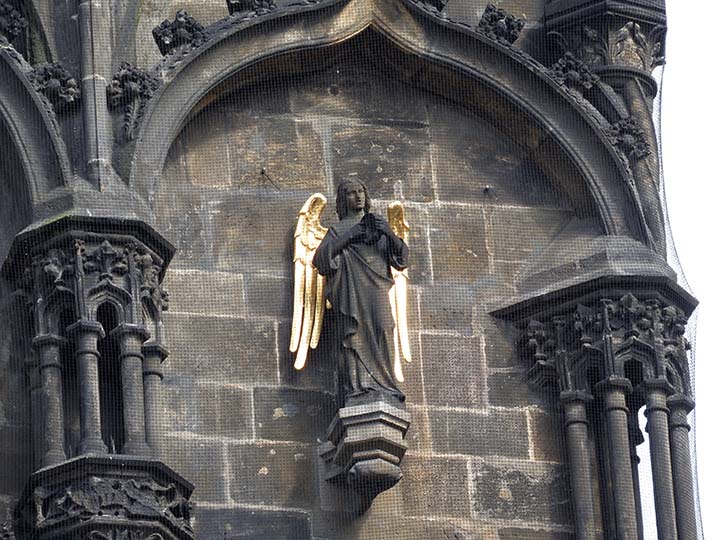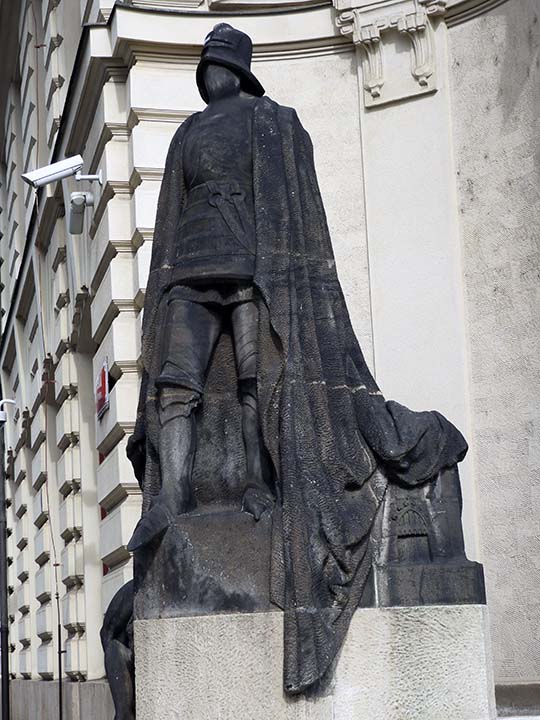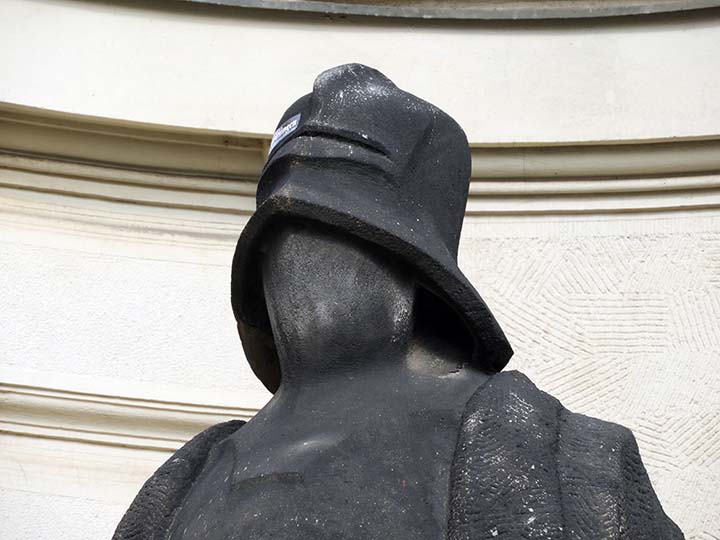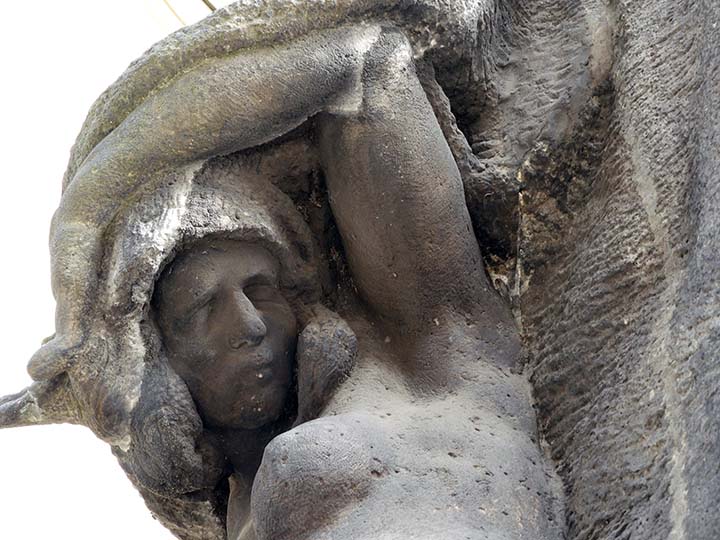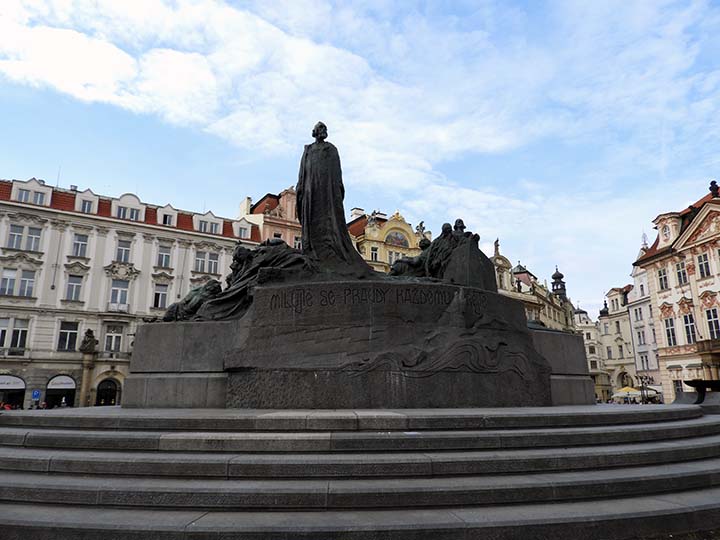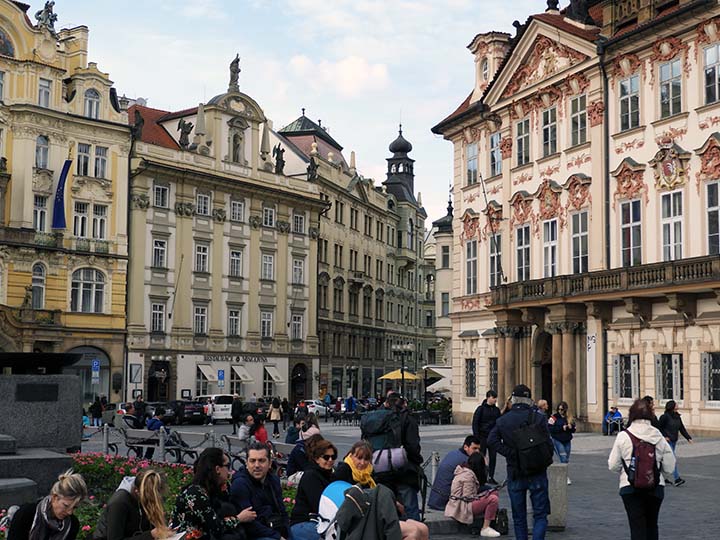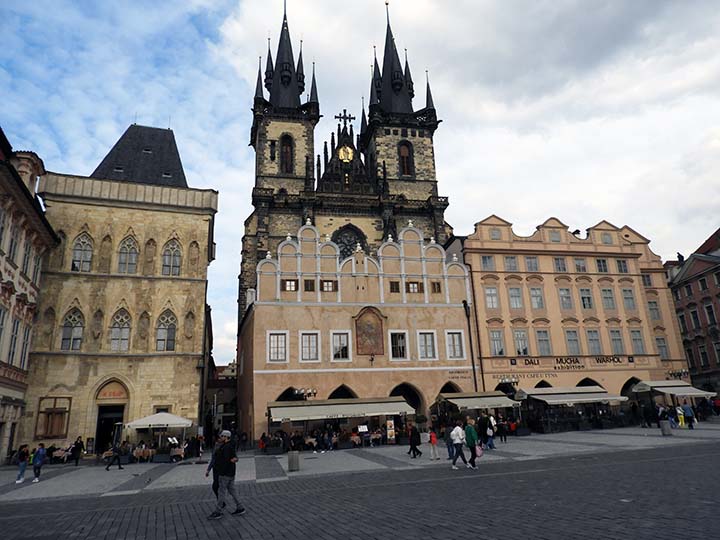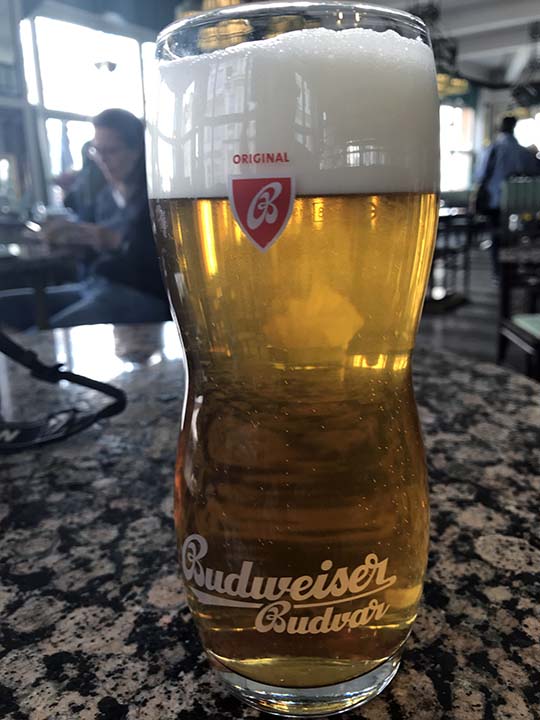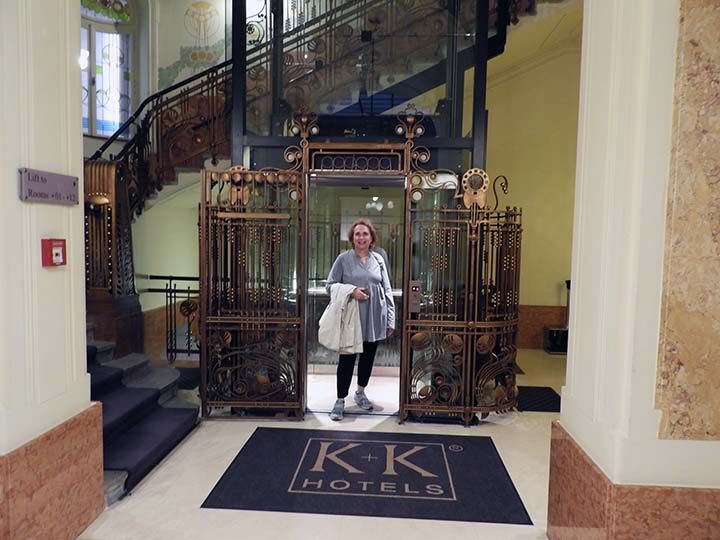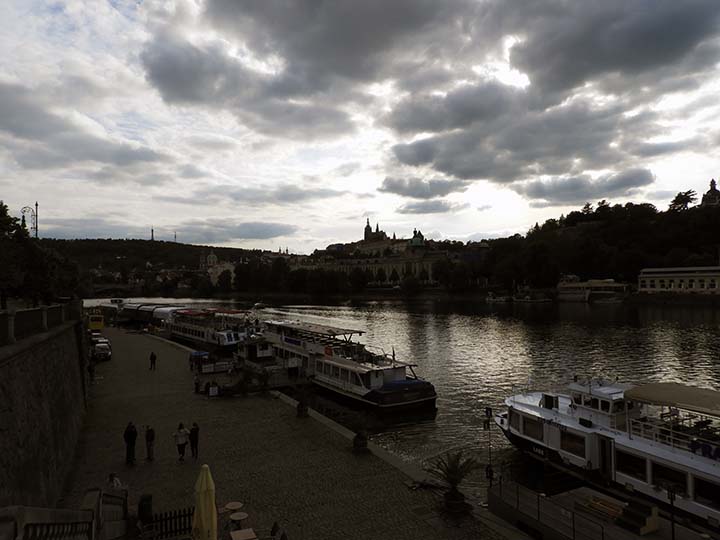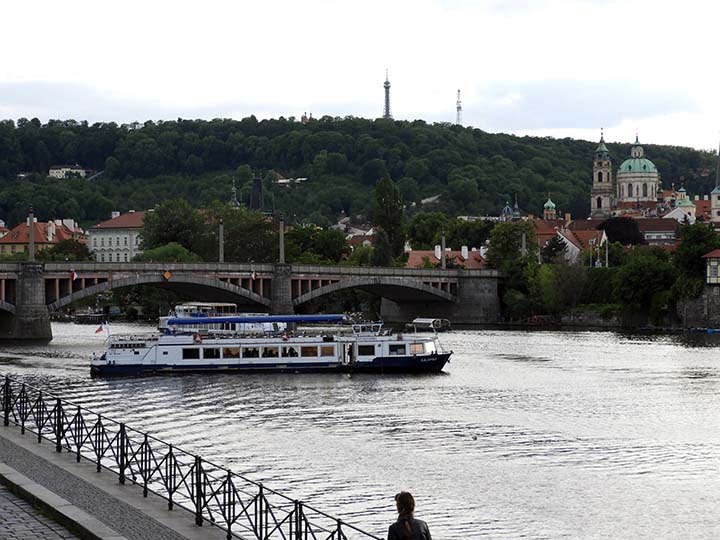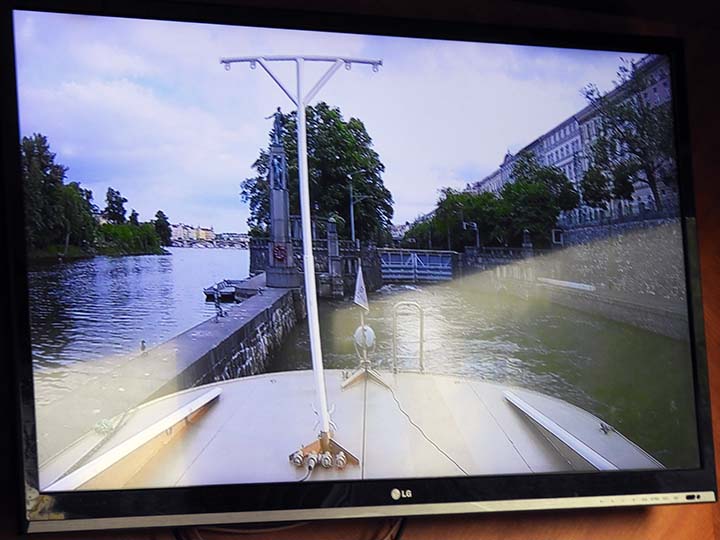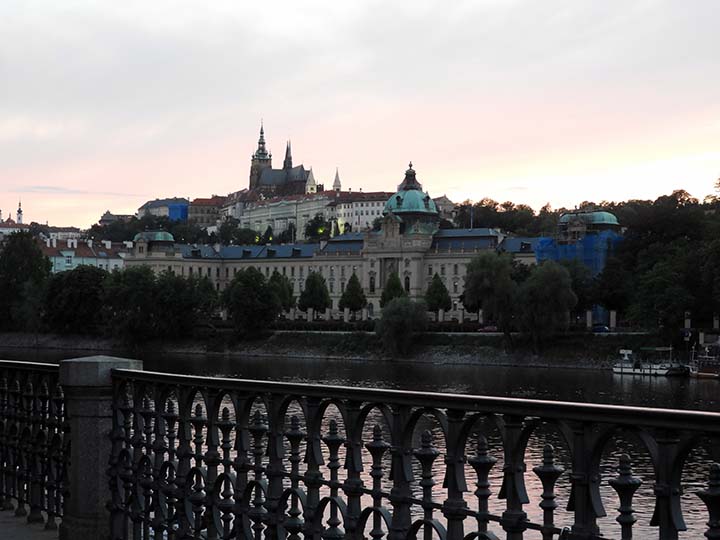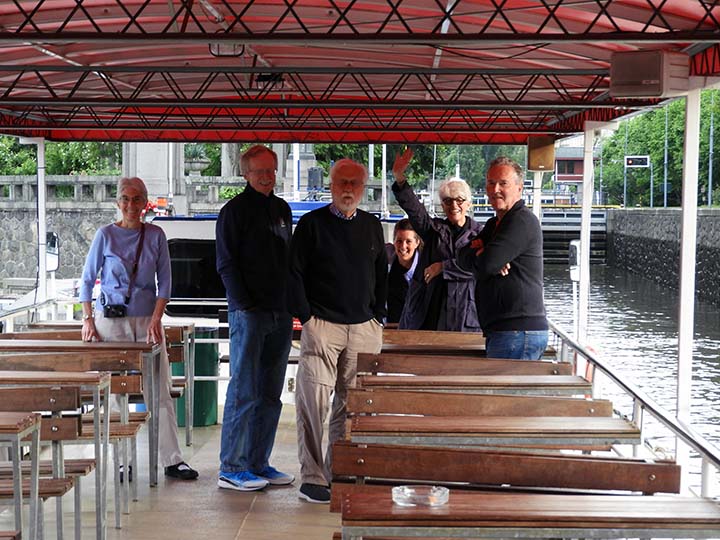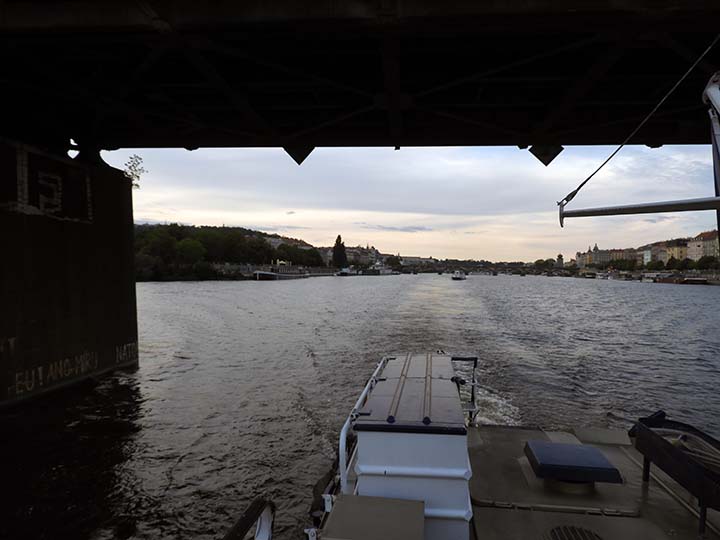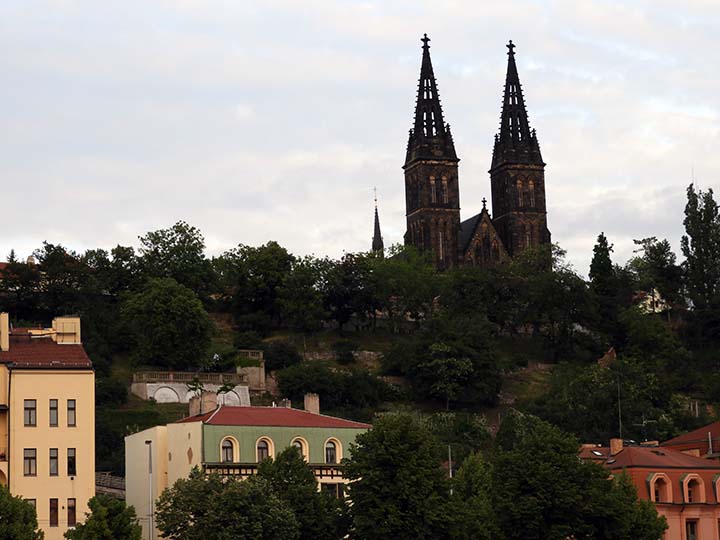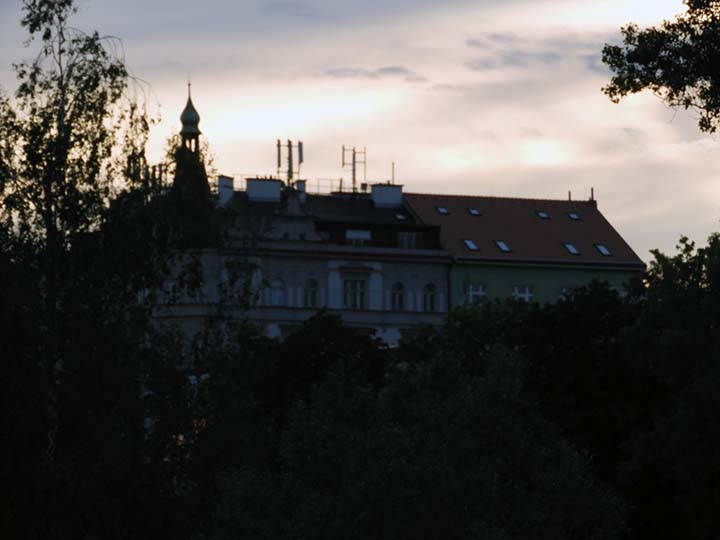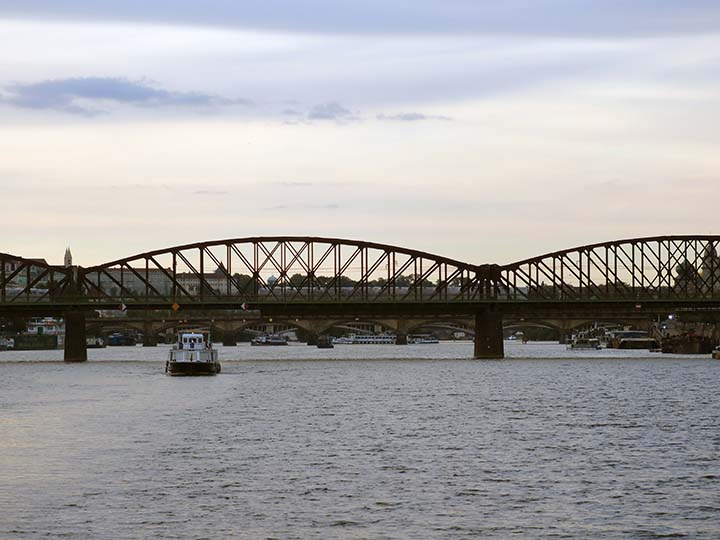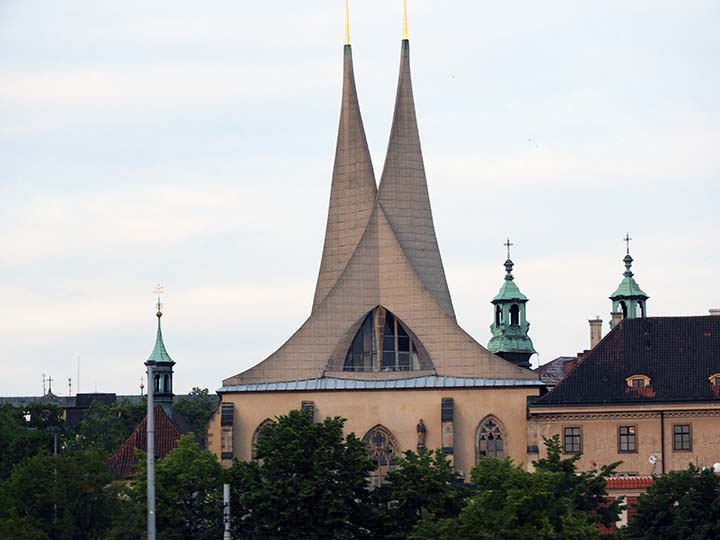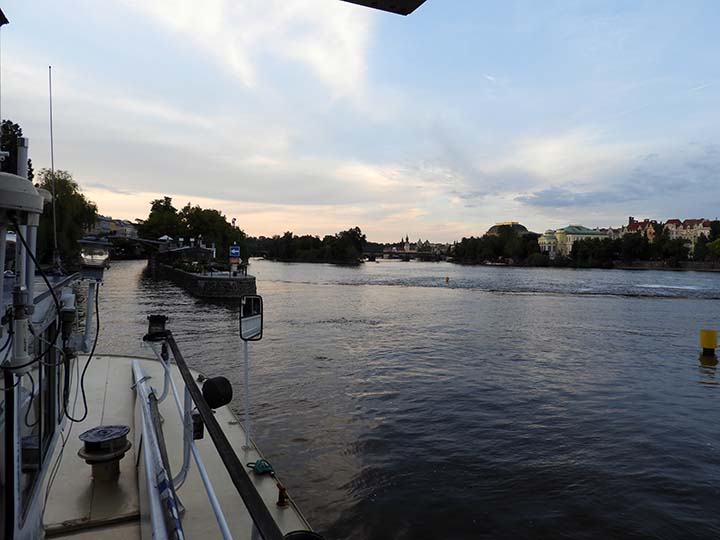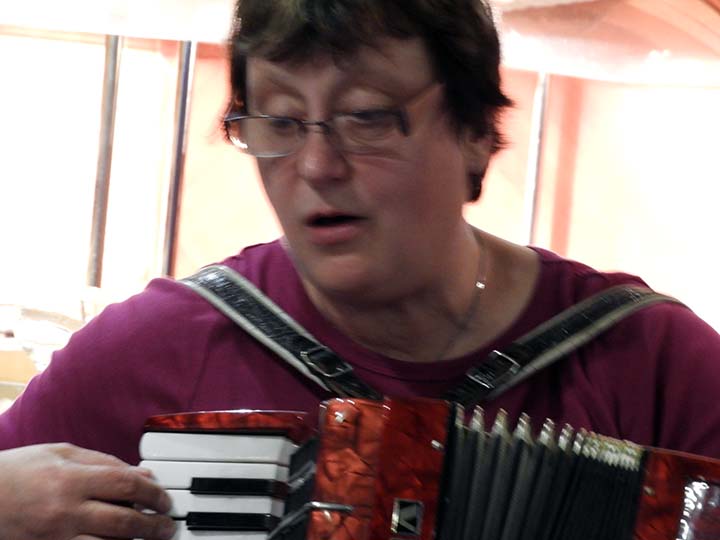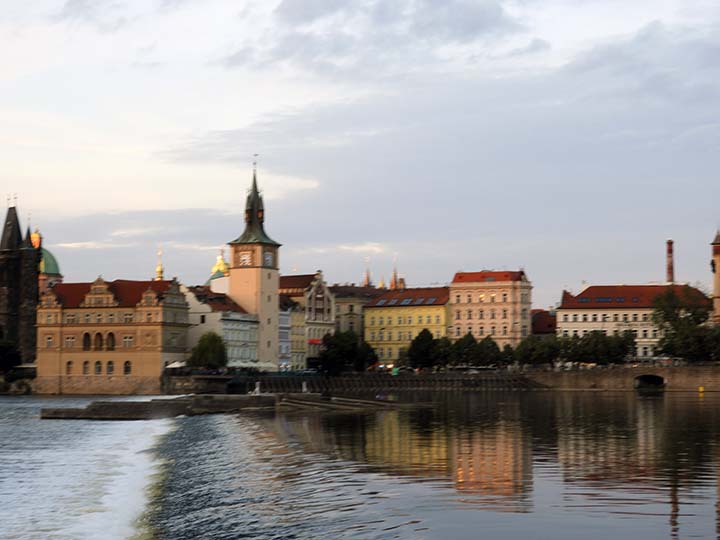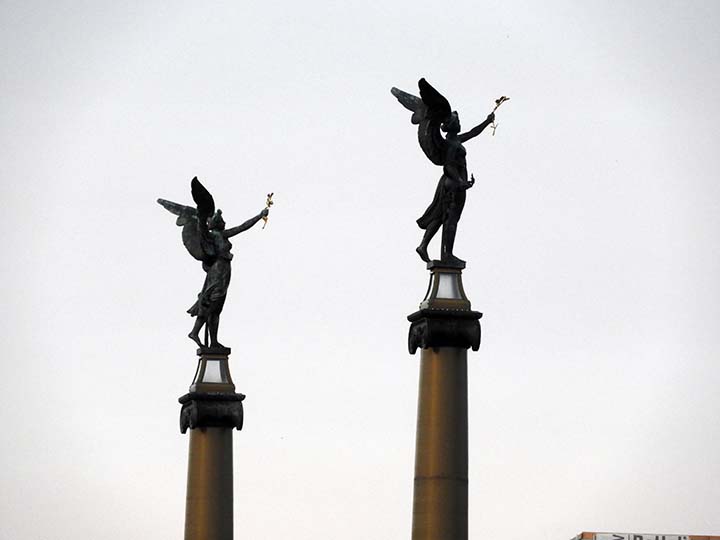|
Today we visited Prague Castle and took a boat ride on the Moldau. I can’t believe tomorrow is the last day for tours, but I do believe I’m about ready to head home. My brain is stuffed with incredible new sights and experiences, and the way they’ve been feeding us my waistline has become overstuffed as well.
We started the day with a very nice lecture on architecture in the Czech Republic.
Then we were off to Prague Castle to see the real thing.
Prague is Misa's home town, so she's our local guide here.
There's art inside. We didn't go in.
Nearing Prague Castle.
Nice grounds.
Prague Castle is a castle complex in Prague, Czech Republic, dating from the 9th century. It is the official office of the President of the Czech Republic. The castle was a seat of power for kings of Bohemia, Holy Roman emperors, and presidents of Czechoslovakia. The Bohemian Crown Jewels are kept within a hidden room inside it.
Misha told us with a smile that the uniforms were designed in Hollywood.
Misa explains it all.
Some of the original foundation.
Misa says that with the new government administration (and maybe increased tourism) it's harder to casually visit the castle now. She says that when she was younger people used to come up here in the evenings just to hang out and mingle and chat.
Lunchtime!
Bill never passes up an opportunity to eat.
Something one might say about the other Road Scholars too.
There are four churches in Prague Castle. This is St. Vitus Cathedral.
That's St. George Basilica over there.
Misa is telling us that the hall was built between 1493–1502 by Benedikt Rejt during the reign of Vladislav II. It was the largest secular space (62m x 16m x 13m) in medieval Prague and belongs to the most complex structural and architectural spaces of the late Middle Ages. Well, I'm paraphrasing (and plagiarizing Wikipedia.)
The hall was used for banquets, receptions, coronations, and other events of the Bohemian court. As I've mentioned, it was even large enough to accommodate tournaments between knights; the "Knight's Stairway" was built wide enough to accommodate horses to facilitate such activities
Those windows are important, but hard to see through the old glass window pane.
I can get a better shot from here. The Defenestrations of Prague were incidents in the history of Bohemia in which multiple people were defenestrated (that is, thrown out of a window). The first defenestration occurred in 1419, second in 1483 and the third in 1618, although the term "Defenestration of Prague" more commonly refers to the third. Often, however, the 1483 event does not count as a "significant defenestration", which leads to some ambiguity when the "second Prague defenestration" is referred to as the 1618 defenestration. First and third helped to trigger a prolonged religious conflict inside Bohemia (the Hussite Wars, 1st defenestration) or beyond (Thirty Years' War, 3rd defenestration), while the second one helped set the religious peace in the country for 31 years. Did you get all that? There will be a test in the morning.
Nice view from the Castle.
Appropriate artwork.
Impressive furniture for a seat of government.
Walk this way.
Don't bump your head.
Road Scholars occasionally mingle with ordinary tourists.
This is St. Vitus Church
And this is St. Vitus dance.
Misa tells us all about it.
The stained glass windows by Alphonse Mucha is stunning.
Coinciding with the Millennium Jubilee of the Czech patron saint St. Wenceslas (Duke of Bohemia), the Gothic reconstruction work for St. Vitas Cathedral in Prague was completed in 1929. The new stained glass window, designed by Mucha, was installed in the north nave in 1931.
There's an organ up there somewhere, I think.
Big place.
If you're impressed by one, you're gonna be impressed by them all.
Misa loved telling us about her Czech heritage.
The Church’s most important monument of the Renaissance period is the marble mausoleum, built in 1571-89 by Dutch sculptor A. Collin; it contains the bodily remains of Ferdinand I Habsburg, his wife Anna and Maxmilian II Habsburg.
The majestic baroque silver tomb of St. John of Nepomuk on the south gallery was created in 1733-36 by goldsmith J. Würth.
The tomb is huge.
Beautiful or gaudy? I liked it anyway.
A small door with seven locks, in the southwest corner of the chapel, leads to the Crown Chamber containing the Czech Crown Jewels, which are displayed to the public only once every (circa) eight years.
Let's go back outside.
Another view of St. Vitus Cathedral.
More of St. Vitus Cathedral.
That's a mosaic of gold. Apparently it has been just recently restored, and that’s why the gold is shiny and not all covered with black soot the way it has been for years.
St. George Basilica again.
That's the Empress Maria Theresa Entrance to the Rosenberg Palace
It means "Golden Lane."And it's right this way.
So let's go see how the working class lived right here next to the castle.
All along the street are restored shops and residences.
Some with pretty decorations.
Others laid out with items of everyday use.
And not all date to the 18th or 19th century. Some homes were used more recently.
Like in the mid-20th centyr.
this guy was a movie buff.
Nice view of Prague from the castle.
Tourists from all over the world had come for the view.
There's a vineyard up here.
With a nice view of some crazy architecture.
There's good food to be found all over Prague, and some of the displays are almost works of art.
:Powder Tower seems dark and ugly, but there's beauty to be found if you look closely.
The crowds are gathering to watch the Astronomical Clock perform on the hour.
It was first installed in 1410, making it the third-oldest astronomical clock in the world and the oldest clock still operating. The clock mechanism itself has three main components: the astronomical dial, representing the position of the Sun and Moon in the sky and displaying various astronomical details; statues of various Catholic saints stand on either side of the clock; "The Walk of the Apostles", a clockwork hourly show of figures of the Apostles and other moving sculptures—notably a figure of Death (represented by a skeleton) striking the time; and a calendar dial with medallions representing the months. According to local legend, the city will suffer if the clock is neglected and its good operation is placed in jeopardy; a ghost, mounted on the clock, was supposed to nod its head in confirmation. According to the legend, the only hope was represented by a boy born on New Year's night. See how it works? Neat, huh?
No, it is not Darth Vader. It was carved in the early 20th century. The statue reminds passers-by of a legend that was associated with the building that had previously stood on this spot. The street on northern side of the square, Platnéřská, is named after the armorers workshops that lined this thoroughfare in the Middle Ages.
According to legend, a war-weary knight in black armor had been seen
wandering around Prague. He ended up in this street to get some work
done on his armor that was worn and chipped after long battles with
the enemy. The craftsman he found had a beautiful daughter who the
knight instantly fell in love with. She repeatedly refused his
advances, infuriating the knight who stabbed her for refusing him.
As she lay on the street, her blood pooling around her golden curls, she cursed her attacker causing the knight to turn to stone.
Great story, but Bill still thinks it's really Darth Vader.
Lots of tourists are out and about on Prague's Old Town Square.
The centerpiece of the square is a memorial to Jan Hus. Who's that, you ask? Born in 1639, Hus was an influential religious thinker, philosopher, and reformer in Prague. He was a key predecessor to the Protestant movement of the sixteenth century. In his works he criticized religious moral decay of the Catholic Church. Accordingly, the Czech patriot Hus believed that mass should be given in the vernacular, or local language, rather than in Latin. Hus was ultimately condemned by the Council of Constance and burned at the stake in 1415. This led to the Hussite Wars.
His memorial is also a handy place to take a break from all the walking.
That turns out to be the Church of Our Lady before Týn.
Prague is a fun place.
Bubbles bubbles
Bubbles everywhere.
See?
Vltava River dinner cruises in Prague are hugely popular with tourists and the water is crowded with boats. The Road Scholars are on board with this.
Because the river is picturesque and the views are spectacular.
Our boat had a TV that displayed a forward view from the pilot deck.
This is the view from the dinner deck.
It's Prague Castle!
Let's see now, what is this?
We've entered a lock to go upstream.
And now we're out on the river again.
That's the Basilica of St. Peter and St. Paul in Vysehrad Fortress.
And that's a pretty sky at sundown.
More pretty stuff. See how this touristry works? You just stand up there on top of the boat and shoot pictures in all directions because it's all so lovely and you figure when you get home you'll remember why you shot that particular bridge, but you don't remember, but that's not important because it's just a pretty picture. Simple.
This is Emmaus, Abbey of the Blessed Virgin Mary and St. Jerome. It was bombed by the US in 1945 and has been rebuilt in a modern style.
This crazy piece of architecture is called the Dancing House, or Fred and Ginger. Click the link to learn all about it.
The sun's going down.
Not bad, is she? It was very nice of her to do this for us.
The setting sun makes the city glow.
See what I mean? That's the National Theater at dusk.
The guy in the hat and blazer standing in his boat made an interesting sight so I snapped a picture. See the swan? I came back to this spot the next day.
Nice.
The statues on the Charles Bridge make a dramatic outline against the late evening sky.
A beautiful way to end a fascinating day.
|

